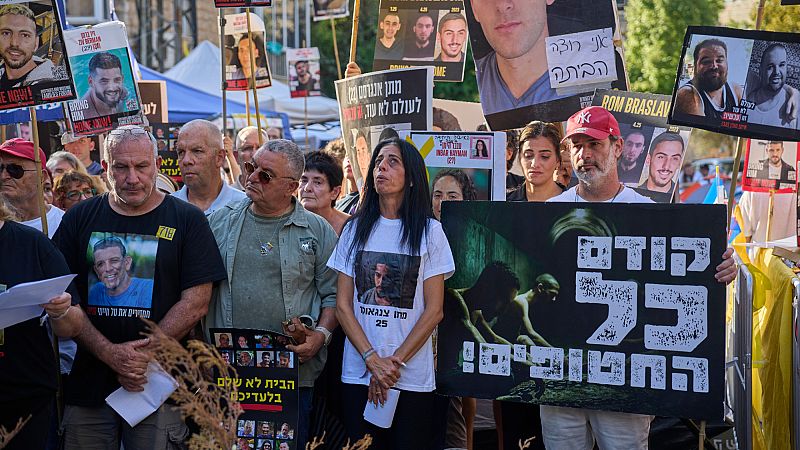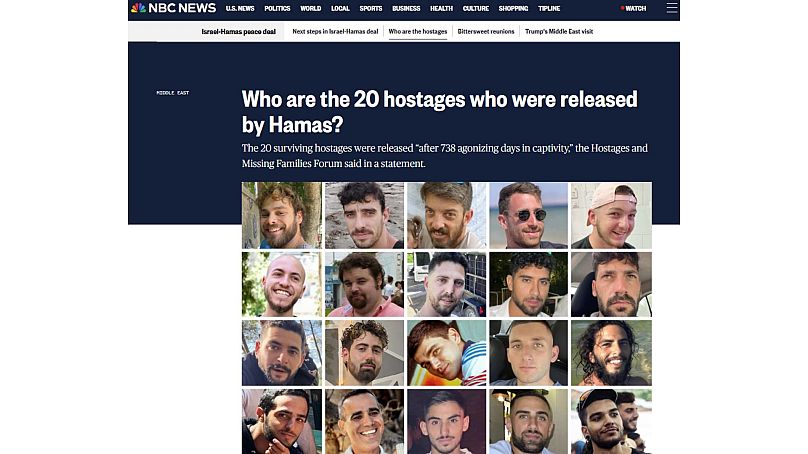Fact-checking claims that no female hostages made it out of Gaza

The 20 remaining living hostages kidnapped by Hamas in the 7 October attacks were released on 13 October as part of a fragile US brokered ceasefire deal with Israel.
Following the breakthrough, a number of European journalists, commentators and social media users relayed the claim that "not a single woman" survived the "horrors" of captivity in a number of posts shared on X, with one publication amassing more than 8 million views.
The remaining 20 living hostages who were released from Gaza are all men, as stipulated in the list released by Hamas, as well as the list compiled by the Hostages and Missing Persons Families Forum.
However, claims shared on social media are misleading, as they disregard the fact that women, civilians and children were prioritised during prior successive hostage deals.
On 7 October 2023, Hamas took 251 hostages from Israel into Gaza, 37 of whom were aged under 18 years old. In total, 51 were women, while 200 were male.
Israeli Prime Minister Benjamin Netanyahu addressed the difficulty of making "tough decisions, between a difficult choice and an even more difficult choice" in November 2023 during hostage negotiations.
At the time, all the hostages who had been released up until that point, were women.
"The effort to bring all of them home is ongoing, and at this time, we can achieve the release of infants and children, mothers and women, who have swords at their necks", added Netanyahu.
Media reports, as well as official communications from the Israel Defence Forces (IDF) and Israeli government, provide a timeline detailing the successive release of female hostages.
On 22 June, the Israeli government stated that of the 251 individuals kidnapped by Hamas on 7 October, 49 were still in captivity, including one woman.
On 15 October, the body of the last female hostage was returned to Israel, following identification carried out by forensic experts.
Although online posts alleging that no female hostages survived Gaza are misleading, many reference the sexual violence experienced by women on 7 October, as well as that faced by captive hostages.
In July, the Dinah Project published a report with first-hand testimonies from 15 former hostages, including one who reportedly was the victim of an attempted rape on October 7.
In exchange for the release of 20 living hostages on 13 October, Israel freed nearly 2,000 Palestinian prisoners, as part of the deal.
Palestinian militants have so far released the bodies of 13 hostages, as Israeli authorities confirmed on Tuesday morning that a body returned on Monday evening had been identified as hostage Tal Haimi.
Yet the ceasefire deal remains in a precarious state: Hamas says it has not been able to reach all of the remains because they are buried under rubble left behind by Israel’s two-year offensive in the Gaza Strip.
Israel has accused the militants of dragging their feet and threatened to resume military operations or withhold humanitarian aid if all of the remains are not returned.
On Sunday, Israel's military accused Palestinian militants of firing troops, killing two Israeli soldiers in areas of Rafah in southern Gaza that are under Israeli control, in line with agreed ceasefire lines.
Retaliatory strikes by Israel killed 45 Palestinians, according to the Gaza Strip's Hamas-run health ministry, which says a total of 80 people have been killed since the ceasefire took effect.
More than 68,000 Palestinians have been killed over the course of Israel's war with Hamas, according to Gaza's health ministry.
Nevertheless, US President Donald Trump assured on Monday that the ceasefire deal was still on track, with Vice President JD Vance arriving in Israel on Tuesday in an effort to strengthen the agreement.
Today



